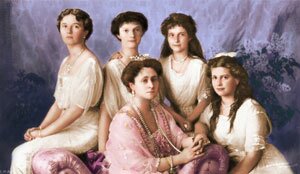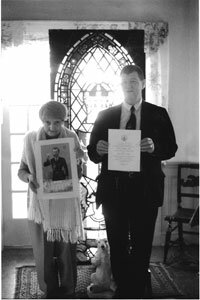ESSAY- Anastasia Manahan: The art of the imposter

The real Anastasia sits at the knee of her mother Alexandra Romanov, in this hand-colored photograph.
FILE PHOTO

The real Anna Manahan and newlywed husband, Jack, hoist an invitation to Richard Nixon's first inaugural and an engraving of Czar Nicholas II, supposedly the blushing bride's late father.
FILE PHOTO BY REY BARRY
The royal imposter is a recurring theme in history and literature, stretching back to ancient times.
It is art, Bram Stoker wrote in his 1910 book on the subject, "that has been practiced in many forms– impersonators, pretenders, swindlers, and humbugs of all kinds; those who have masqueraded in order to acquire wealth, position, or fame, and those who have done so merely for the love of art."
Franziska Schanzkowska dosen't appear to have been an outright swindler or a humbug. Where she fell on the impersonator-pretender spectrum is a mystery. Either as an act of desperation or psychotic break, she wove a fiction around herself so tightly that it not only became her reality, it became reality for countless others.
Don't recognize the name? Not surprising. But you know Franziska Schanzkowska... you just know her as Anna Anderson, or in her later incarnation as Charlottesville resident Anastasia Manahan. You know her as the woman who, for over fifty years, insisted she was the Grand Dutchess Anastasia, the sole survivor of the martyred Romanov family.
Fished out of a Berlin canal in 1920 in a failed suicide attempt, the uncommunicative Fraülein Unbekannt (Miss Unknown) was in and out of German mental and general hospitals for several years, slowly revealing her "true" identity as the the daughter of the Czar Nicolas II and Empress Alexandra.
She insisted that she had survived the carnage that had killed the rest of her family at the coda of their captivity under the Bolsheviks in the Siberian town of Ekaterinburg on July 18, 1918– wounded, scarred by bullets and bayonets, but shielded from death by the body of her sister Tatiana– and spirited away by a guard named Alexander Tchaikovksy.
She said he took her to Budapest, married her, and gave her a son before dying in a street brawl. Then, she had come to Germany to try to reunite with her extended family, living in exile.
From the start, the tale told by "Anna Anderson" was full of contradictions. She bore a resemblance to Anastasia, but experts noted dissimilarities as well. Where Anastasia had been playful and clever, she was querulous and eccentric. She spoke no Russian or English, as Anastasia would have, but did speak German... a language Anastasia was never taught.
She seemed to know a great deal about the Romanovs and their private lives, but was often mistaken on important details. Romanov relatives, who hadn't seen much of Anastasia in the years leading up to the Russian Revolution, were split on her veracity. German courts puzzled over her case for a record-setting 32 years before deciding she had not adequately proven her identity.
For many people over the decades, those details never mattered. They simply made the story more deliciously mysterious. Neither have the several DNA studies beginning in 1994 that have shown, to a high degree of probability, that Anastasia Manahan was not genetically related to the Romanovs and that she was genetically related to the Schanzkowski family. How, they argue, can you reduce a living, breathing human being to a few cells in a petri dish?
Those last true-believers are not even likely to be swayed by the latest evidence released earlier this month: DNA confirmation that two bodies found outside Ekaterinburg in 2007 were the "missing" Romanovs, Anastasia's brother Alexei and her older sister, Marie.
It's a good example of how, even in the age of DNA, people have trouble with the idea of an incontrovertible proof.
Sometimes it just gets in the way of a good story. We don't necessarily need to believe in science. We do need to believe that goodness can triumph over tragedy. Without the survival at least one of the Czar's children, the Romanov murders are a portrait of young people dying a horrific death before they even had a chance to live. It takes a lot of Disney magic to turn that into something heartwarming.
More often, it disrupts an emotional investment people have made in a person they have taken into their hearts. Imposters play on our fundamental belief that nobody would lie about about something as existential as identity.
"I know one thing for certain," said one of Mrs. Manahan's longtime friends and supporters. "Anastasia was not a Polish peasant."
In a sense, he was right: she wasn't. The fascinating thing about the Anastasia story is that, at some point, it transcended truth, history, DNA, or deception.
Franziska Schanzkowska picked up the broken thread of Anastasia Romanov's life and made it her own. Anastasia lost her future to revolution; to live Anastasia's life, Franziska had to give up her past.
Anastasia saved Franziska from becoming an nameless suicide in a Berlin morgue; Franziska saved Anastasia from being overlooked by history. Now, there's no way to tell the story of one without telling the story of the other. Through the sheer determination of the survivor, two lives have been merged into one.
It is, as Stoker might say, a work of art.
~
Heather Michon is a former Vermonter turned Charlottesvillian who is an avid essayist for OpenSalon.com, a community blogging platform launched by Salon.com last summer.
#